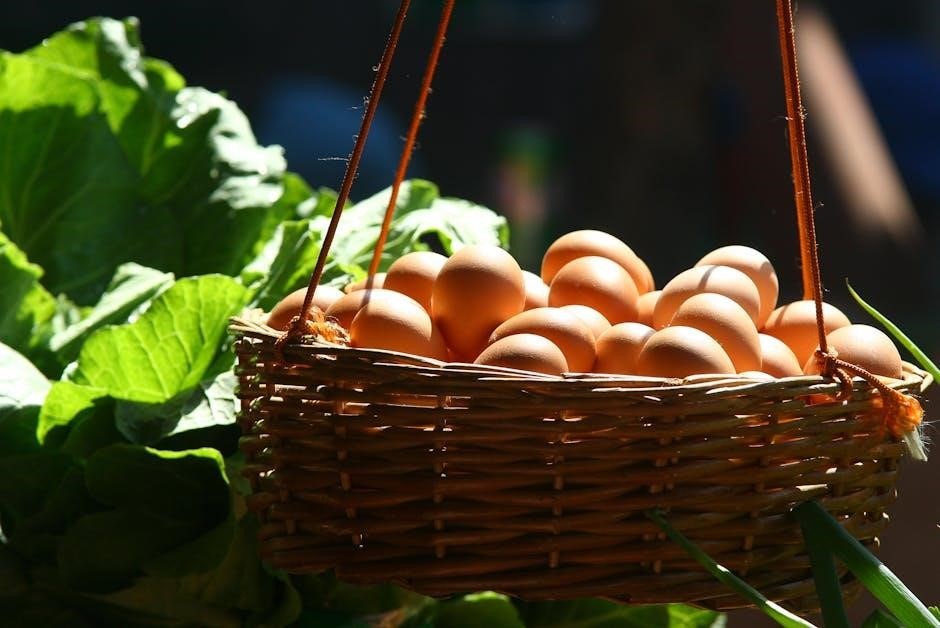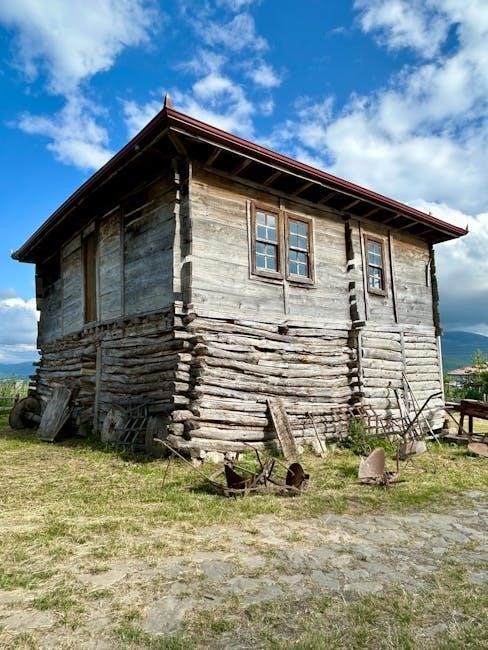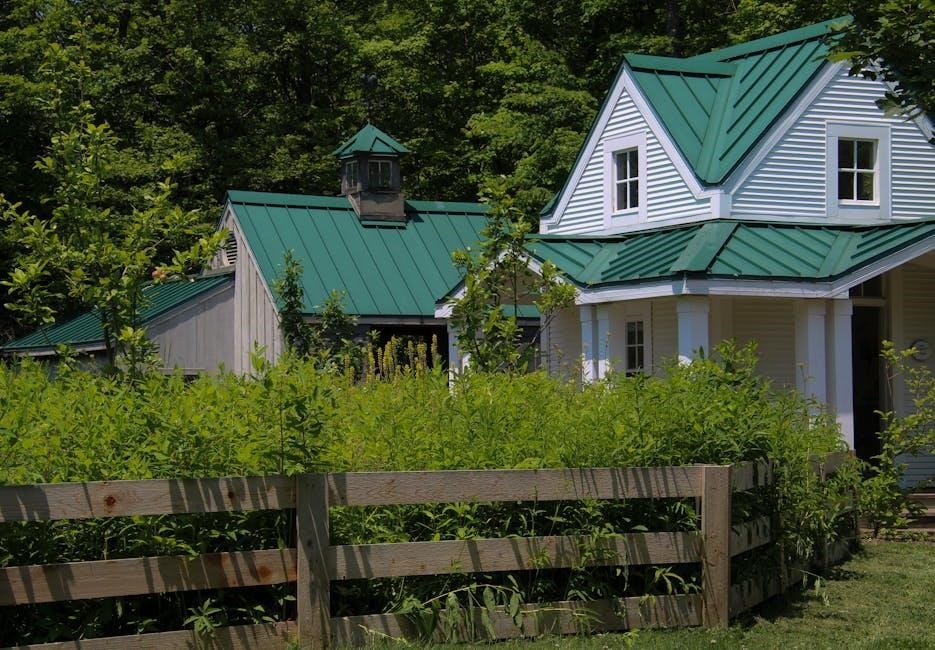Homesteading is a self-sufficient lifestyle focused on growing your own food, preserving resources, and living sustainably. It empowers individuals to embrace independence and connect with nature.
What is Homesteading?
Homesteading is a lifestyle centered on self-sufficiency, embracing natural living, and sustainable practices. Rooted in historical traditions, it involves growing food, preserving resources, and relying less on external systems. Modern homesteading adapts these principles to various settings, from rural farms to urban backyards. It emphasizes independence, environmental stewardship, and community building, empowering individuals to live more intentionally and connect with the land. Homesteading fosters resilience and creativity, offering a fulfilling path to a simpler, more sustainable way of life.
Historical Context of Homesteading
Homesteading traces its roots to the Homestead Act of 1862, which granted 160 acres of land to U.S. citizens willing to farm it for five years. This policy aimed to expand westward settlement and promote agriculture. Historically, homesteaders relied on subsistence farming, manual labor, and resourcefulness to thrive. The movement shaped rural communities and self-reliant living, laying the foundation for modern interpretations of homesteading as a sustainable and independent lifestyle.
Modern Homesteading: A Self-Sufficient Lifestyle
Modern homesteading is about embracing a self-sufficient lifestyle, whether on acres of land or in urban spaces. It involves growing your own food, preserving resources, and reducing reliance on industrial systems. Homesteaders today prioritize sustainability, often incorporating renewable energy, rainwater collection, and waste reduction. Urban homesteading adapts these principles to smaller spaces, emphasizing DIY projects like gardening, food preservation, and crafting. This lifestyle fosters resilience, health, and a deeper connection to the environment and community, making it accessible to everyone.
Planning Your Homestead
Planning your homestead involves assessing land, resources, and goals to create a sustainable lifestyle. Start by evaluating your space and needs, then develop a clear strategy.
Choosing the Right Location for Your Homestead
Selecting the right location is crucial for a successful homestead. Consider factors like climate, soil quality, and access to water. Urban areas offer limited space but allow for small-scale projects, while rural settings provide more land for farming and livestock. Ensure local regulations support homesteading activities. Proximity to markets and communities can also impact your lifestyle. Choose a location that balances your resources, goals, and personal preferences for a sustainable homestead.
Assessing Your Land and Resources
Evaluating your land and resources is essential for a thriving homestead. Start by assessing soil quality, water availability, and sunlight patterns. Consider zoning laws and environmental factors like flood zones or wildlife habitats. Inventory existing resources, such as trees, water sources, and natural shelter. Test your soil to determine its suitability for gardening. Identify areas for potential projects, like a garden or animal shelter. This evaluation will help you maximize your land’s potential and create a sustainable homestead. Plan accordingly to ensure efficiency and productivity.
Creating a Sustainable Homestead Plan
A sustainable homestead plan begins with clear goals and a realistic timeline. Prioritize self-sufficiency by balancing food production, energy use, and waste management. Consider your budget and available resources to avoid debt. Start small, focusing on essential projects like a garden or water collection system. Gradually expand as skills and resources grow. Regularly review and adapt your plan to address challenges and ensure long-term viability. This approach fosters resilience and ensures a harmonious, eco-friendly lifestyle for years to come.

Food Production and Preservation
Homesteading focuses on growing and preserving food to ensure self-sufficiency. Techniques like canning, dehydrating, and fermenting help store harvests for year-round use, promoting sustainability and flavor preservation.
Gardening: Growing Your Own Food
Gardening is a cornerstone of homesteading, allowing you to grow fresh, nutritious food. Start small with easy crops like green beans or herbs, even in containers or vertical gardens. Assess your space and sunlight to choose the right plants. Soil preparation and composting are key for healthy growth. Whether on a balcony or acreage, gardening connects you to the land and ensures a steady food supply. It’s a rewarding way to cultivate sustainability and self-sufficiency, no matter your location or experience level.
Cooking from Scratch: Essential Kitchen Skills
Cooking from scratch is vital for homesteaders, offering control over ingredients and nutrition. Start by planning meals and using whole foods. Skills like bread-making, fermentation, and food preservation are key. Preserve seasonal produce through canning, dehydrating, or fermenting. Simple recipes, like artisan bread, can become daily staples. These practices not only save money but also enhance flavor and health. They empower homesteaders to create nourishing meals year-round, fostering self-reliance and a deeper connection to their food.
Food Preservation Techniques: Canning, Dehydrating, and Fermenting
Mastering food preservation is key to homesteading. Canning, dehydrating, and fermenting allow you to enjoy seasonal produce year-round. Water bath canning is ideal for jams and pickles, while pressure canning works for meats and vegetables. Dehydrating removes moisture, preserving foods like fruits and herbs. Fermentation creates nutrient-rich foods like sauerkraut and kimchi, boosting probiotics. These techniques ensure self-sufficiency, reduce waste, and provide healthy, flavorful meals. Start simple and grow your skills to preserve abundance efficiently.
DIY Food Projects: Bread, Cheese, and Home Brewing
Homesteaders can craft delicious staples at home. Bread-making is simple with flour, water, yeast, and salt, offering fresh loaves daily. Cheese production starts with milk, yielding varieties like ricotta or mozzarella. Home brewing involves fermenting ingredients to create beer, kombucha, or mead. These projects enhance kitchen skills, reduce reliance on stores, and bring joy to meals. They also foster creativity and self-sufficiency, making every bite and sip a testament to your labor and resourcefulness.
Managing Livestock on Your Homestead
Managing livestock involves selecting suitable animals, building proper shelters, and ensuring their health. It’s crucial for a sustainable homestead, providing food and enhancing self-sufficiency.
Choosing the Right Animals for Your Homestead
Selecting the right animals for your homestead involves considering space, resources, and your family’s needs. Start with hardy, low-maintenance options like chickens or rabbits. For dairy, consider goats or cows if space permits. Ensure the animals align with your homestead goals, whether for eggs, meat, or milk. Research breeds suited to your climate and care capabilities to ensure a sustainable and productive homestead.
Building Infrastructure for Livestock: Fencing and Shelters
Building infrastructure for livestock requires durable fencing and suitable shelters. Use high-quality materials like wood, metal, or vinyl for fencing, ensuring it is tall and sturdy enough to contain your animals. Shelters should provide protection from weather and predators, with adequate ventilation and drainage. Consider the specific needs of each species, such as chicken coops or goat sheds. Start with essential structures and expand as your homestead grows. Proper infrastructure is key to the health and safety of your livestock.
Caring for Animals: Feeding, Health, and Maintenance
Caring for livestock involves providing high-quality feed, ensuring proper health, and performing routine maintenance. Feed should be tailored to each animal’s needs, such as grains for chickens or hay for goats. Regular veterinary check-ups and vaccinations are essential to prevent diseases. Daily chores include cleaning shelters, refilling water, and monitoring for signs of illness. Maintain fencing and shelters to ensure safety and comfort. Consistent care fosters healthy, productive animals, which are the backbone of a successful homestead.

Water and Energy Management
Water and energy management are crucial for sustainable living. Collecting rainwater, conserving resources, and utilizing renewable energy like solar and wind reduce reliance on public utilities and promote eco-friendly practices;
Collecting and Conserving Water
Water conservation is vital for homestead sustainability. Consider installing rainwater collection systems, such as barrels or tanks, to gather and store rain for irrigation and household use. Conserve water by fixing leaks promptly and using efficient irrigation methods like drip systems. Store water in clean, well-maintained containers to ensure quality. Additionally, implement practices like mulching to reduce evaporation and using drought-resistant plants to minimize water consumption. These strategies help preserve this precious resource for long-term self-sufficiency.
Solar Power and Renewable Energy for Homesteads
Solar power offers a sustainable energy solution for homesteads, reducing reliance on grid electricity. Install solar panels to harness sunlight, providing power for homes, water pumps, and appliances. Consider off-grid systems with battery storage for energy independence. Wind turbines and micro-hydro systems can complement solar, offering additional renewable energy sources. These technologies enable homesteaders to lower energy costs, reduce carbon footprints, and maintain functionality during outages. Transitioning to solar and renewable energy supports a self-sufficient and eco-friendly lifestyle.
Off-Grid Energy Solutions
Off-grid energy solutions empower homesteaders to rely on renewable resources like solar, wind, and micro-hydro systems. These systems reduce dependence on public utilities, lowering costs and environmental impact. Energy storage, such as batteries, ensures consistent power supply. Wind turbines complement solar panels, especially in areas with strong winds. Micro-hydro systems harness water flow for electricity. Together, these technologies provide a sustainable, independent energy framework, enabling homesteaders to thrive without grid reliance while maintaining a self-sufficient lifestyle.

Waste Management and Recycling
Effective waste management and recycling are crucial for a sustainable homestead. Composting organic waste creates nutrient-rich soil, while repurposing materials reduces landfill use and promotes eco-friendly living.
Composting: Turning Waste into Resources
Composting transforms kitchen scraps and yard waste into nutrient-rich soil, reducing landfill use and fostering sustainable gardening. Start by collecting organic materials like fruit peels, vegetable remnants, and leaves. Add these to a designated compost area, balancing “green” items (like food waste) with “brown” materials (like dried leaves). Regularly aerate the pile to ensure decomposition. Over time, this process creates a natural fertilizer, enriching your soil and promoting healthy plant growth, making it a cornerstone of homestead sustainability and eco-friendly living.
Reducing Waste in Your Homestead
Minimizing waste is crucial for a sustainable homestead. Start by reusing items creatively, such as turning old containers into storage or repurposing fabric scraps. Avoid single-use products and opt for bulk purchases. Composting food waste reduces landfill contributions and creates fertilizer. Repairing rather than replacing items extends their lifespan. Implementing these practices not only conserves resources but also aligns with the homestead’s goal of self-sufficiency and environmental stewardship, fostering a more mindful and eco-conscious lifestyle for the entire family.
Repurposing Materials: Creative Homestead Solutions
Repurposing materials is a cornerstone of homesteading, fostering creativity and sustainability. Transform old containers into planters or storage solutions. Pallets can become shelves, fences, or even animal shelters. Fabric scraps can be sewn into reusable cloths or quilts. Metal cans and jars are perfect for organizing supplies or storing food. By thinking outside the box, homesteaders reduce waste and create functional, eco-friendly solutions, ensuring nothing goes to waste while maintaining a self-sufficient lifestyle.

Building a Homestead Community
Building a homestead community fosters collaboration and support among like-minded individuals. Sharing knowledge, skills, and resources strengthens bonds, creating a resilient network for sustainable living and mutual growth.
Connecting with Other Homesteaders
Connecting with other homesteaders provides invaluable support and knowledge. Joining online forums, attending local workshops, and participating in community gardens fosters relationships and shared learning. These networks offer practical advice, inspiration, and encouragement, helping homesteaders overcome challenges and celebrate successes together. Building these connections strengthens the homesteading journey, creating a sense of belonging and collaboration.
Learning from Experienced Homesteaders
Experienced homesteaders offer insights and wisdom gained from years of practice. Their knowledge spans gardening, food preservation, and animal care. By learning from mentors, newcomers can avoid common mistakes and adopt proven strategies. Workshops, books, and online communities provide platforms to access their expertise, ensuring a smoother transition to a self-sufficient lifestyle. Their guidance is invaluable for building resilience and confidence in homesteading endeavors.
Sharing Knowledge and Skills
Sharing knowledge and skills fosters a sense of community among homesteaders. Workshops, online forums, and local groups provide platforms for exchanging ideas. Teaching others about gardening, food preservation, and animal care strengthens collective expertise. Collaborative efforts encourage innovation and problem-solving, ensuring everyone thrives. This mutual support system is essential for sustaining a self-sufficient lifestyle and empowering future generations of homesteaders.

Continuous Learning and Growth
Homesteading requires constant learning and adaptation. Skills like gardening, food preservation, and animal care evolve over time. Embrace lifelong learning to enhance self-sufficiency and resilience.
Essential Skills for Homesteaders
Mastering essential skills is crucial for homesteaders. Gardening, food preservation, and cooking from scratch are foundational. DIY projects, like bread-making and cheese production, enhance self-sufficiency. Learning to manage waste through composting and creating natural cleaning products reduces reliance on external resources. Animal care, including feeding and health maintenance, is vital for livestock homesteads. These skills empower homesteaders to thrive independently, fostering resilience and sustainability in their daily lives.
DIY Projects for Homestead Improvement
DIY projects enhance homestead functionality and sustainability. Building a greenhouse, creating rainwater systems, and crafting herbal remedies are practical improvements. Repurposing materials for storage solutions or fencing saves resources. These hands-on tasks foster creativity and self-reliance, empowering homesteaders to improve their property efficiently while reducing costs and environmental impact.
Adapting to Challenges on the Homestead
Homesteading often presents unexpected challenges, such as crop failures, animal health issues, or equipment malfunctions. Adaptability is key to overcoming these obstacles. Learning to problem-solve creatively and staying flexible ensures resilience. Building a support network with other homesteaders can provide valuable advice and resources. Embracing challenges as opportunities for growth fosters a stronger connection to your land and lifestyle, empowering you to thrive despite setbacks.
Embark on your homesteading journey with confidence! Explore resources like The Encyclopedia of Country Living and online forums for guidance, and connect with local homesteading communities.
Final Thoughts on Starting Your Homestead
Congratulations on taking the first step toward a self-sufficient lifestyle! Homesteading is a journey, not a destination, and it’s okay to start small. Begin with what you have, whether it’s a garden, DIY projects, or preserving food. Celebrate small victories and learn from challenges. Surround yourself with supportive communities and resources to guide you. Remember, homesteading is about independence, sustainability, and reconnecting with nature. Embrace the process and enjoy the rewards of a simpler, more fulfilling life.
Recommended Books and Guides for Homesteaders
Essential books like The Encyclopedia of Country Living by Carla Emery and The Self-Sufficient Life and How to Live It by John Seymour provide timeless wisdom. For modern insights, explore guides by Joel Salatin, Melissa K. Norris, and Rory Feek; Online resources like The Homestead Guide and forums offer practical tips and community support. These resources will empower you to navigate homesteading challenges and thrive in your self-sufficient journey, whether you’re a beginner or an experienced homesteader.
Online Communities and Forums for Homesteaders
Connecting with online communities like Homestead Living Forum and Homesteading.com offers invaluable support. These platforms share knowledge on topics from gardening to livestock care. Websites such as American FarmSteadHers and The Homestead Guide provide expert articles and personal experiences; Engaging with these resources fosters learning and collaboration, helping homesteaders build a sustainable lifestyle and overcome challenges together, creating a strong network for success in their self-sufficient journey.
